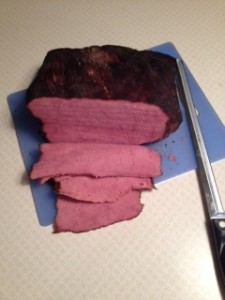In a past blog post I showed the processing of a beef gooseneck round into restructured corned beef and pastrami like items. To view that story click here. While those items were easy to produce and tasty, there doesn’t currently seem to be any demand for them. This article is another attempt at adding worthwhile value to underutilized gooseneck rounds.
Here the gooseneck is seamed-out into the eye, bottom and heel of round. The only place one might find bone-fragments on a gooseneck round is near the thick end (dorsal end) of the eye. However there is a large piece of silver-skin on the exterior of the bottom/flat/outside round, some other heavy connective tissue and a large popliteal lymph node which all need to be trimmed out. Since there was too much fat for normal ground beef I freshened the surface of all the subcutaneous (outside) fat. Throwing out such trim fat is a good e-coli precaution; especially since we like to enjoy juicy burgers. The eye is optimal for beef jerky production, the dorsal end of the bottom round can be fabricated into a nice rump roast and the ventral end of the bottom round & the heel make excellent Choice ground round. High quality ground beef (does not contain any old cow meat) is versatile and delicious in many different culinary applications.
Here the 5 pound rump roast & 4 pound eye are both denuded of fat, the 2 trimmings piles on the left are lean & fat for ground round and the small pile on the right is 2 1/2 pounds of waste. Starting gooseneck round cost was $3.65 per pound; trimming loss took the usable meat cost to $4.01 per pound.
Well-chilled fat trimmings and the rat tail (Super Digital Flexor) went through a 3/16 inch hole size grinder plate; discharging into lean trimmings and a handful of ice cubes. Next, all was ground through the same plate then mixed by hand in a meat lug. Total weight of 75% lean Choice ground round was 16 1/2 pounds. The denuded eye roast went to make beef jerky. All steps for eye of round jerky production were covered in another Pork & Beef Express post, click here to see them.
This 5 pound green weight rump roast was pumped with brine containing the following soluble ingredients: 1 tsp. of Prague powder # 1, 2 3/4 Tbsp. purified salt, 1 Tbsp. brown sugar and 3 cups of water. I didn’t use sodium phosphate or cure accelerator.
Coarse ground black pepper and crushed garlic were boiled with 1 cup of water then chilled and added to the roast brine. The roast was soaked for 4 days in order to assure uniform curing. It was flipped once a day during the brining period.
To start the smoke cycle 2/3 of a charcoal chimney of briquettes was partially lit and spread thin on the Wolfer smoke-cooker’s fire grate. Next, chunks of crabapple wood were placed on top of the briquettes. After the cooker was closed temperature range was maintained, and hardwood was kept smoldering, by adding more partially lit briquettes down the flue/fuel pipe. If you want to learn more about Wolfer Smoke-Cooker operation click here. Roast was lightly smoked for 5 hours at an average temperature of 195F.
After 5 hours of low-heat smoke-cooking the roast was at 125F internal. It was left on the wire rack; the rack & roast were placed on a cookie sheet then everything went into a 180F oven.
After 2 hours in an 180F oven the internal temperature only went up 8 degrees to just 133. Since the exterior was looking dry I put the rack and roast in a covered roasting pan then put it back in the 180F oven for 3 hours, hoping I hit 160F. When using a home oven for long-low heat cooks check the owner’s manual to see how long it will stay on without automatically shutting off (safety feature). You might have to periodically reset the oven when cooking at low temperatures.
Even though the oven was set at only 180, the increased humidity in the closed roaster greatly accelerated the rate of heat transfer into the roast. When I checked the internal temperature after 3 hours it was at 170F. I had been hoping to pull the roast at 160 and have it climb to 165 while resting, but in actuality it had hit 170 by the time I checked and did not climb any higher because of the very low cooking temperature.
Cooked yield was 76% of green (trimmed, starting raw) weight. End product was very flavorful; with a nice semi-dry beef texture. The use of sodium phosphate would have made it too corned beef/pastrami like.












